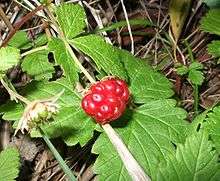Rubus arcticus
| Rubus arcticus | |
|---|---|
 | |
| From "Bilder ur Nordens Flora" (1917–1926) | |
| Scientific classification | |
| Kingdom: | Plantae |
| (unranked): | Angiosperms |
| (unranked): | Eudicots |
| (unranked): | Rosids |
| Order: | Rosales |
| Family: | Rosaceae |
| Genus: | Rubus |
| Subgenus: | Cyclactis |
| Species: | R. arcticus |
| Binomial name | |
| Rubus arcticus L. 1753 | |
| Subspecies[1] | |
| |
| Synonyms[2] | |
| |
Rubus arcticus, the Arctic bramble[3] or Arctic raspberry,[4] is a species of slow-growing bramble belonging to the rose family, found in arctic and alpine regions in the Northern Hemisphere.
Its dark red fruit is considered a delicacy. In the Pacific Northwest of western Canada and the northwestern United States, it is sometimes called the nagoon or nagoonberry, a name which derives from the Tlingit neigóon. A measure of the quality of its fruit is expressed in its Russian name княженика knyazhenika, signifying the "berry of princes". It grows in Alaska, northern Scandinavia, Russia, Poland, Belarus, Mongolia, northeastern China, North Korea, Estonia, Lithuania, Canada, and the northern United States as far south as Oregon, Colorado, Michigan, and Maine.[5][6][7]
Description
Rubus arcticus grows most often in acidic soils rich in organic matter. It is a thornless perennial up to 30 cm (1 foot) tall, woody at the base but very thin farther above the ground. flowers are in groups of 1-3, the petals pink, red, or magenta. Fruit is deep red or dark purple, with an unusual hardiness to frost and cold weather conditions.[1][8]

Uses
The fruits of the Arctic raspberry are very tasty and, among other uses, make jam and liqueur, or flavour tea. Carl von Linné considered the Arctic raspberry – åkerbär in Swedish – a great delicacy in his Flora Lapponica (1737). Also used in Smirnoff Ice and North, and Lignell & Piispanen's Mesimarjalikööri, and Wine fruit of Arctic RaspBerry (Central Arctic in Adub). Arctic raspberry is the provincial plant of the Norrbotten province of northern Sweden.[9][10][11]
See also
- Rubus chamaemorus - Cloudberry
References
- 1 2 Alice, Lawrence A.; Goldman, Douglas H.; Macklin, James A.; Moore, Gerry (2014). "Rubus arcticus". In Flora of North America Editorial Committee. Flora of North America North of Mexico (FNA). 9. New York and Oxford – via eFloras.org, Missouri Botanical Garden, St. Louis, MO & Harvard University Herbaria, Cambridge, MA.
- ↑ "Rubus arcticus L.". Richard Pankhurst et al. Royal Botanic Gardens Edinburgh – via The Plant List.
- ↑ "BSBI List 2007". Botanical Society of Britain and Ireland. Archived from the original (xls) on 2015-01-25. Retrieved 2014-10-17.
- ↑ "Rubus arcticus". Natural Resources Conservation Service PLANTS Database. USDA. Retrieved 24 October 2015.
- ↑ "Rubus arcticus L. - Åkerbär". Den Virtuella Floran (in Swedish). Naturhistoriska riksmuseet. 1996: description, ecological information, photos.
- ↑ "Rubus arcticus". State-level distribution map from the North American Plant Atlas (NAPA). Biota of North America Program (BONAP). 2014.
- ↑ "Rubus arcticus : Nagoon Berry". Central Yukon Species Inventory Project (CYSIP). Friends of Dempster Country; includes photos, description, line drawing, global distribution map.
- ↑ Lu, Lingdi; Boufford, David E. "Rubus arcticus". Flora of China. 9 – via eFloras.org, Missouri Botanical Garden, St. Louis, MO & Harvard University Herbaria, Cambridge, MA.
- ↑ "Rubus arcticus". Plants for a Future.
- ↑ "Berry Crops". Inverness, Scotland: University of the Highlands and Islands. Archived from the original on 2006-08-18.
- ↑ Karp, K.; Starast, M.; Värnik, R. (1997). "The arctic bramble (Rubus arcticus L.) – the most profitable wild berry in Estonia" (PDF). Baltic Forestry. 2: 47–52; in English with summary in Russian.
External links

- photo of herbarium specimen at Missouri Botanical Garden, collected in Finland